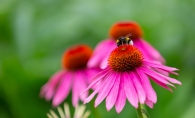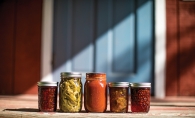The summer sun wanes, to be replaced by a lovely Minnesota fall, and with the approaching chill, gardening might not be the first thing on your mind. But “September is an excellent time to plant,” says Diane Peterson, horticulturalist at Fair’s Nursery. September is the time to plant perennials so that after a long winter, your garden will be bursting with color in the spring. And the best thing about perennials is they don’t take a lot of work to grow and can even thrive in your garden.
Coneflowers (Echinacea)
These beautiful flowers, accurately named for their cone-shaped appearance, come in several different colors with the most popular being white, yellow and burgundy. Coneflowers are hardy plants that can grow up to three feet tall and are great for beginning gardeners because they require little maintenance. They are best planted in full sun. With their tolerance of hot, dry conditions, you don’t have to water them a lot once they’re established.
“I like them because hummingbirds and butterflies are attracted to them and they are easy to grow,” Peterson says. Plus, the seeds can be used as bird food to draw more birds to your garden. “You can also cut them and bring the flowers in,” she says. Coneflowers have a nice fragrance that is not too strong, which make them a great addition to a natural centerpiece made of flowers.
Perennial Hibiscus (Hibiscus moscheutos)
If you’d like to add a tropical feeling to your garden, the hardy hibiscus never fails to transport you to a sunny paradise without the hassle of traveling. Reaching heights of three to four feet tall and growing three feet wide, you will need a larger area to grow this “shrub-like” plant. The hardy hibiscus also has large flowers. Fair’s Nursery offers white, pink and red tones that grow to be about the size of an adult hand.
Peterson says that there is only one possible drawback to growing hibiscus. “It is kind of late to emerge in the spring so you have to be patient with them, but it’s worth it because you get a giant flower in the fall,” she says. September is a fantastic time to add hibiscus to your yard because you are able to see its beautiful flower immediately when you plant it, and also have the plant ready to bloom the following year.
Perennial Sage (Salvia officinalis)
Perennial sage comes in deep purple and pink tones and grows up to 24 inches. There are also different varieties of sage that grow to differing heights depending on what you would like for your garden. “I like them because they have such a nice, spiked flower,” Peterson says. These plants are usually disease- and mostly insect-free, which makes them a great flower to bring into the house without the worry of carrying little critters inside.
Best in full sun, these plants also attract humming birds and butterflies. Peterson has grown perennial sage in her own garden and enjoyed the experience. “I just like how full it gets and it has lots of flowers. It’s very showy and would be good for beginner gardeners,” she says. Because it grows so full and bushy, it takes up a nice area in the garden.
Autumn Joy (Hylotelephium telephium)
Autumn Joy, also known as sedum or stone crop, grows about 24 inches tall with a spread of 18-20 inches. This plant also thrives best in full sun and is extremely easy to grow. Almost like a succulent in regard to water intake and care, it grows best in well drained soils. If your soil is rich in clay, as most Maple Grove soil is, adding compost or soil conditioner to the area helps these plants grow better.
One of the best aspects about planting Autumn Joy in September is that its flower will stay on throughout fall and winter. The dry, pink flower can be left out all winter long and hold snow. “It’s something interesting to see during that time of the year instead of just a flat garden,” Peterson says. Come next spring, all you need do is cut it and watch it grow right back up again.
Fair’s Nursery offers expert gardening advice throughout the year. A landscaping crew is also available to install the plants of your choice.









